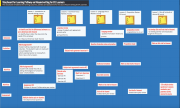Wikieducator.org/Résumé writing for EFL Learners/Design blueprint
Résumé writing for English as a Foreign Language (EFL) Learners/Design blueprint
Metadata
- Intermediate to advanced level adult EFL students
- 20 to 40 learning hours
- Awarded digital badge
Intended target audience
This course is aimed at intermediate and advanced level EFL students who are interested in learning how to prepare and write their own American style résumés proving they have capability to select and apply multiple concepts and rules involved in writing a résumé.
Any prerequisite knowledge required
Possession of the the required English proficiency, intermediate level or equivalent, to be apt to take the instructional unit.
Aims and outcomes
- to identify and list the differences between a c.v. and a résumé correctly.
- to write the 1st draft of an American style résumé including its 4 sections: identification and contact info, career goals, career experience, achievements (publications, awards).
- to lay out a résumé in MS Word on 8.5 x 11 paper with special attention to visual appearance and use of white space.
- to know how to tailor the résumé to the needs of the employer correctly.
- to improve reading and vocabulary skills.
- to review preposition usage, subject-verb agreement, word forms and phrasal verbs.
Proposed delivery approach
This course will be put together using CC-BY-SA instructional materials I have previously developed. Students will be encouraged to search the Internet, discuss and share differences on cv and résumé formats, share their résumés with other peers, work collaboratively, do short reading assignments, and do online multiple-choice, short answers or scramble exercises. After an initial period of familiarization with the résumé format, students will start working on the 1st draft of their own personal résumé. The final product, 3rd draft of the résumé, is tailoring the résumé to meet the needs of a potential employer.
As students become more familiar with résumé writing, they will be encouraged to share their résumé drafts via the wiki and their own personal blogs.
Assessment strategy
Once students have demonstrated their knowledge of résumés by uploading a résumé they have created and by posting some hints and tips to help others to create their own résumés then they will be awarded a digital badge.
Interaction strategies
- Student-student: by providing feedback to other students' tasks; helping other students with difficulties; and working collaboratively to form an asynchronous community of inquiry for the course.
- Student-teacher: by providing direct instruction and guidelines for students to accomplish tasks; ensuring all students are on track with their tasks; facilitating an engaging asynchronous community of inquiry; and providing ongoing feedback to students.
- Student-content: independent studying fostered by providing structured instructional materials such as individualized reading tasks, videos and multiple choice exercises and quizzes.
Interaction strategies are based on Anderson’s (2003) Equivalency interaction theorem that posits that:
“Deep and meaningful formal learning is supported as long as one of the three forms of interaction(student–teacher; student-student; student-content) is at a high level. The other two may be offered at minimal levels, or even eliminated, without degrading the educational experience. High levels of more than one of these three modes will likely provide a more satisfying educational experience, though these experiences may not be as cost or time effective as less interactive learning sequences”[1]. (n.p.)
- ↑ Anderson, T. (2003). Getting the Mix Right Again: An Updated and Theoretical Rationale for Interaction. The International Review Of Research In Open And Distributed Learning, 4(2).Retrieved from http://www.irrodl.org/index.php/irrodl/article/view/149/230
Opportunities for collaboration
After passing its initial test stage, this course could be offered as a MOOC, in collaboration with other universities or foreign language teaching institutions.
